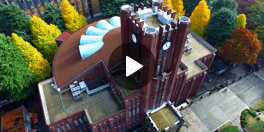マルチメディア情報資料の高度アーカイブ構築拠点A center for advanced archiving of diverse media materials
社会情報研究資料センターは、新聞資料を中心に、各種メディア情報資料を研究するために収集・整理し、それらの資料を学内外の研究者の利用に供しています。
社会情報研究資料センターは、1964年1月、新聞研究所内に開室された「プレスセンター」が1967年6月、新聞研究所附属施設「新聞資料センター」として正式に発足し、1992年4月に新聞研究所が社会情報研究所に改組されるにあたって「情報メディア研究資料センター」と改称された施設を前身としています。2004年4月、情報学環と社会情報研究所の組織統合にともなって「社会情報研究資料センター」と改称し、現在に至っています。
本センターの収蔵資料は、製本済原紙約6,000冊、縮刷版約8,000冊、マイクロフィルム約45,000リールに達しています。閲覧室には各種データベース閲覧用PCとマイクロリーダーを設置しています。オンライン化された新聞記事データベースや映画・映像関係データベースは学内もしくはセンター内で利用できます。また、定期刊行物として『社会情報研究資料センターニュース』を刊行しています。
2007年度から5年間に亘り、本センターでは、整理保存機能の高度化、利活用機能の高度化、教育研究機能の高度化、情報化アーカイブ 機能全般の高度化という理念に基づき、「高度アーカイブ化事業」を実施し、利便性・公開性の向上、劣化マイクロフィルムの救済、貴重資料の保管システムの整備、既存のアナログアーカイヴのデジタル化、新規のデジタルアーカイブの構築、情報ネットワークの構築等を行いました。
これまで、社会情報研究資料センターおよび情報学環・学際情報学府図書室に収蔵されている貴重資料を中心に、以下のようなデジタルアーカイブを作成し閲覧できるようになっています。
新聞研究所の初代所長である小野秀雄(1885-1977)は、新聞学の発展に中心的な役割を果たすとともに、かわら版や新聞錦絵の収集を長年続けました。このコレクションは、江戸時代のかわら版約600枚、明治初期の新聞錦絵約400枚(約280種)を含んでおり、極めて貴重な資料として知られています。このデジタルアーカイブでは、情報学環所蔵のかわら版及び新聞錦絵の画像や読み下し(800点以上)のデータを公開しています。
第一次世界大戦において、情報戦術の発達や国内大衆に向けたプロパガンダの役割の高まりを受け、ポスターの宣伝技術が急速に発達しました。その後、外務省情報部が総力戦体制に向けた準備としてそれらの宣伝資料を集めました。第二次世界大戦が終結すると、これらの資料は不要とされ、新聞研究所に移されたとされます。このデジタルアーカイブでは、国際的に見ても極めて貴重である「第一次世界大戦期プロパガンダ・ポスター」のコレクションを「社会情報研究資料センターDigital Cultural Heritage(ベータ版)」において公開しています。
森恭三(1907-1984)は、戦後日本を代表するジャーナリストの一人です。朝日新聞論説主幹を務め、長年にわたって『朝日ジャーナル』の巻頭言を執筆していました。新聞研究所及び社会情報研究所の非常勤講師も務めていました。森氏のご遺族から社会情報研究所に寄贈いただいた様々な資料は、研究目的に限って、社会情報研究資料センター及び情報学環・学際情報学府図書室で閲覧することができます。
The Multi-media and Socio-information Studies Archive is a center for the collection, preservation and provision of media materials (especially newspapers) for researchers at the University of Tokyo and elsewhere.
The roots of the Archive go back to January 1964, when the “Press Center” was established in what was then known as the Institute of Journalism and Communication Studies. In June 1967 it was renamed as the “Newspaper Archive”. Following the foundation of the Institute of Socio-information and Communication Studies (ISICS) in April 1992, it came to be known as the “Newspaper and Multi-media Library”. It acquired its current name in April 2004, following the merger of ISICS with the III.
The archive holds approximately 6,000 bound volumes, 8,000 volumes of reduced newspaper editions, and 45,000 reels of microfilm. The reading room is equipped with computer terminals for access to digital archives and microfilm readers. Online databases of newspaper articles and visual media materials can be accessed in the Archive’s reading room or from anywhere on the university campus. The archive also produces a regular newsletter (in Japanese).
The Archive has embarked on an “Advanced Archiving Project” based on the principle of advancing preservation techniques, user access, education/research functions and digital database archiving. This project involves increasing the level of public access to materials, saving microfilms from physical deterioration, establishing systems for the storage of precious materials, digitalization of existing analogue archives, creation of new digital archives, and information network construction.
At the present time, the following digital databases based on rare materials held in the Archive have been created and made available to the public:
Ono Hideo Collection (Japanese Only)
Hideo Ono (1885-1977) was the founding director of the Institute of Journalism and Communication Studies and played a key role in the development of journalism studies in Japan. He was also a keen collector of historical media materials, especially of kawaraban (illustrated news sheets from the Edo era) and nishiki-e (early Japanese newspaper illustrations). The resulting collection, now held at the III, contains about 600 kawaraban and 400 nishiki-e. The digital archive of these extremely rare and valuable materials contains high-quality visual images and textual data on each item.
World War I Propaganda Poster Collection (Japanese Only)
Propaganda techniques advanced rapidly at the time of the First World War in response to the growing importance of information warfare and domestic propaganda. Posters were one of the main propaganda media at that time. After the war, the Information Bureau of the Japanese government collected propaganda posters from around the world as materials for use in the preparations for all-out war. After defeat in the Second World War, the Japanese government no longer had any use for these materials and deposited them at the Institute of Journalism and Communication Studies. Given the extreme rarity of this collection, the III’s digital archive of World War I propaganda posters is a very valuable resource for researchers all over the world.
Kyozo Mori (1907-1984) was one of Japan’s leading postwar journalists. He was a chief editorial writer for the Asahi Newspaper and for many years a leader writer for the weekly Asahi Journal. He also taught courses in the Undergraduate Research Program of the Institute of Journalism and Communication Studies (now part of the III). Following his death, various materials were donated by his surviving relatives and are now accessible for research purposes at the Socio-information and Communication Studies Archive.
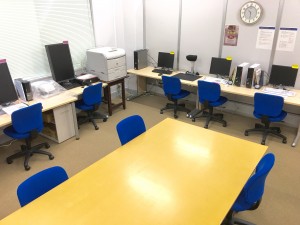
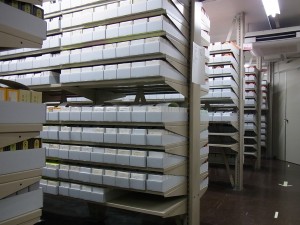
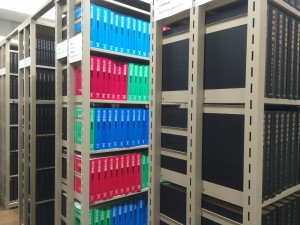
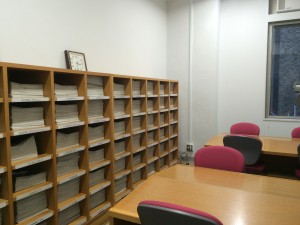
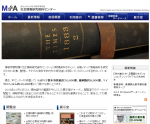
社会情報研究資料センター
http://www.center.iii.u-tokyo.ac.jp/
各種マルチメディア資料を収集・保存・公開しています。社会情報学のアーカイブ構築研究の基盤となっています。
Multi-media and Socio-information Studies Archive
http://www.center.iii.u-tokyo.ac.jp/english
This center collects and preserves all kinds of multi-media materials and makes them available to the public as a research resource. It is also a center for research on advanced archiving.

